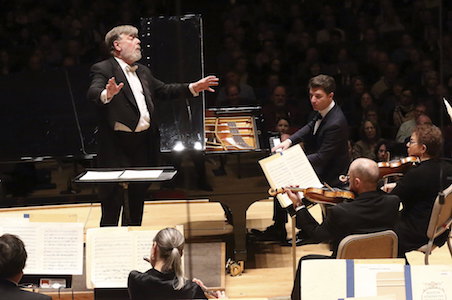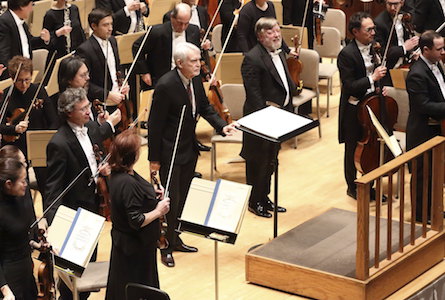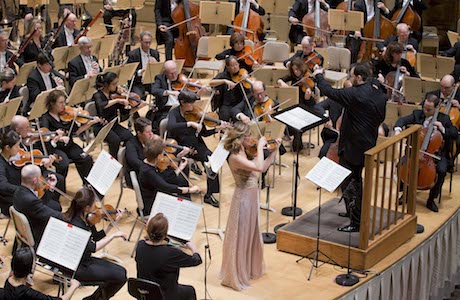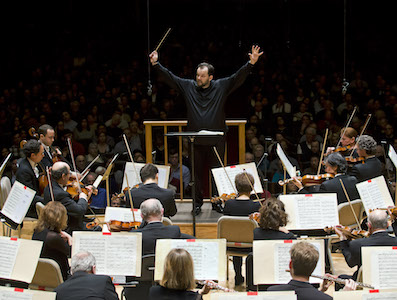Three Concerts
|
Grant Chu Covell [June 2019.]
The best concerts deliberately position stepping stones that enable a surefooted stream crossing. Thinking back to the start of the year, the Boston Symphony Orchestra designed several such journeys. I’m startled to realize how well today’s pattern of Overture — Concerto — Symphony actually works. Surely the organizers’ minimum desire is that one part might satisfy the majority; and, perhaps, that each part might satisfy different constituents. A difficult new piece might be paired with a warhorse. One of the oldest reviewers’ tricks is to compare two things. In this case, any two concerts. Column inches can be filled quickly documenting similarities and differences without having to dig deep into either event. The BSO concerts of January 10 and January 29 actually beg comparison. In each, a Mozart piano concerto was framed by a compact contempo piece and a hefty symphony (or two). For good measure I’ll toss in one more evening concert (February 12) that fits the pattern. * * * John HARBISON: Symphony No. 2 (1986). W.A. MOZART: Piano Concerto No. 24 in C minor, K. 491 (1786). Ralph VAUGHAN WILLIAMS: Symphony No. 5 (1938-43). Alessio Bax (pno), Boston Symphony Orchestra, Sir Andrew Davis (cond.). January 10, 2019, 8:00 p.m., Symphony Hall, Boston. (http://www.bso.org/). Kaija SAARIAHO: Ciel d’hiver (2013). W.A. MOZART: Piano Concerto No. 22 in E-flat major, K. 482 (1785). Jean SIBELIUS: Symphony No. 6 (1923); Symphony No. 7 (1924). Martin Helmchen (pno), Boston Symphony Orchestra, John Storgårds (cond.). January 29, 2019, 8:00 p.m., Symphony Hall, Boston. (http://www.bso.org/). Olly WILSON: Lumina (1981). Karol SZYMANOWSKI: Violin Concerto No. 1, Op. 35 (1916). Aaron COPLAND: Symphony No. 3 (1946). Lisa Batiashvili (vln), Boston Symphony Orchestra, Andris Nelsons (cond.). February 12, 2019, 8:00 p.m., Symphony Hall, Boston. (http://www.bso.org/).
On January 10, the journey began with John Harbison’s Second Symphony. In Boston, Harbison is considered our most senior composer and this performance acknowledged his 80th birthday. When James Levine was music director, he programmed all six Harbison symphonies, although circumstances prevented him from actually conducting each one. (The BSO recordings were discussed here.) Also marking the occasion, the Boston Philharmonic offered No. 3 last year. Tackling the symphonic form late in his career, Harbison coaxes his Second into something more like a single-movement tone poem describing a day whose parts run without breaks: “Dawn,” “Daylight,” “Dusk,” and “Darkness.” No. 2 lacks the friskiness (or jazz) we find in Nos. 1 or 3; there are no vocalists as in Nos. 5 and 6. Under Andrew Davis’ command this particular evening, the work appeared overcast and foggy, perhaps due to ensemble unfamiliarity. Harbison’s Second was followed with Mozart’s Concerto No. 24. Alessio Bax immediately launched into Romanticism, asking questions that the orchestra never answered. The performance slid quickly into mundanity, disappointing because the C-minor concerto offers room for passionate drama. Vaughan Williams’ Fifth bears a most wonderful dedication: “Dedicated without permission to Jean Sibelius.” I had not heard this symphony in a very long time, and while I do not seek out the Vaughan Williams’ symphonies (except to demonstrate the corny chord progression that opens No. 1), I would have enjoyed the grittier Fourth or the militant Sixth far more. No. 5 is simply too meandering and nice, and consequently infuriating and forgettable. However, the audience was pleased.
January 29th was the BSO’s last performance of Kaija Saariaho’s Ciel d’hiver. I realize, perhaps evident to everyone else, that the BSO will thicken music it does not understand. I wonder whether it is a learned habit to play music loudly when it is unfamiliar. Saariaho’s attempts at transparency were smudged. As with the Harbison only weeks before, I am certain details were lost under heavy footwork. Contrasting Bax, Martin Helmchen fared better with his Mozart concerto, No. 22 in E-flat, and there was more interaction between orchestra and soloist. The balance might have been improved if there were fewer violins. Any late Sibelius symphony is a treat. John Storgårds presented the two closely related Nos. 6 and 7. Sibelius’ output declined after 1926. Was it alcoholism? Self-doubt? A combination? With their false windows and trap doors that dispense with traditional forms, these works can also be emotionally exhausting. Sibelius was not happy, and whether it was the BSO’s intent, this pair had gravity and sorrow.
Olly Wilson’s Lumina began the February 12th concert. Flashier than the Saariaho which appeared weeks before, it too suffered from modest conviction. It would have been grand to have heard Lumina repeated. Szymanowski’s First violin concerto is an intricate glowing ember, keeping the soloist busy across a single multi-part movement like the Wilson which preceded it. There was more conviction, but features were blurred Copland’s Third Symphony anchored this program (the composer preferred “Third Symphony” as a title over “Symphony No. 3”). I suspect after a predominantly unfamiliar first half, everyone anxiously awaited the appearance of the Fanfare. Copland would be less of a miniaturist than Wilson and Szymanowski, and so the symphony fared well under Andris Nelsons’ leadership.
It’s worth noting that Copland’s Third was written for the BSO, and the audience was asked to keep the noise down as they were making a recording. This might explain why the Third had more presence than either the Wilson or Szymanowski. * * * New music will not fill the hall, but popular classics will. Thus, the most familiar can be offset by the obscure. I generally pick concerts with contemporary pieces. Whether familiar to me or not, I prefer new stuff over most anything else. The rest of the audience is probably there because they like the soloist, concerto or symphony. However, I am doubly pleased when the concert is balanced. [Sir Andrew Davis with Alessio Bax, photo by Hilary Scott; John Harbison with Sir Andrew Davis, photo by Hilary Scott; Kaija Saariaho with John Storgårds, photo by Robert Torres; Lisa Batiashvili with Andris Nelsons, photo by Winslow Townson; Andris Nelsons, photo by Winslow Townson.]
[More Grant Chu Covell]
[Previous Article:
Of Infertile Soil]
|




